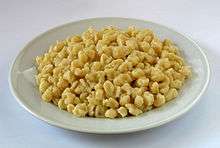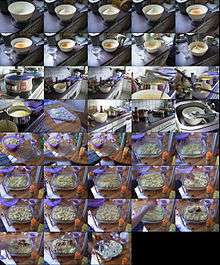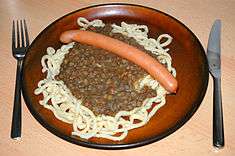Spätzle



Spätzle [ˈʃpɛtslə] (Swabian diminutive plural of Spatz, thus literally "little sparrows", also Spätzli or Chnöpfli in Switzerland or Knöpfle or Hungarian Nokedli, Csipetke or Galuska) are a kind of soft egg noodle found in the cuisines of southern Germany and Austria, Switzerland, Hungary, Alsace, Moselle and South Tyrol.
Etymology
The linguistic origin of Spätzle is debated.[1] Literally translated, Spätzle means "little sparrows".
Before the invention and use of mechanical devices to make these noodles, they were shaped by hand or with a spoon and the results resembled Spatzen (plural of Spatz, meaning sparrows, sparrow is Spatz or Sperling in German; Spätzle is the diminutive of Spatz, unchanged in plural).
Knöpfle means "small buttons" and describes the compact form of this spätzle variety.
History
The geographic origin of spätzle is not precisely known; various regions claim to be the originators of this noodle. Written mention of „Knöpflein“ und „Spazen“ als „alles was aus Mehl zubereitet wird“ has been found in documents dating from 1725 by Lentilus a counselor and personal physician of Württenberg, although medieval illustrations are believed to place this noodle at an even earlier date.[2]
Today in Germany, spätzle are largely considered a "Swabian speciality"[3] and are generally associated with the German state of Baden-Württemberg. In France they are associated with Alsace and Moselle. The total estimated annual commercial production of spätzle in Germany is approximately 40,000 tons.[4] Pre-made spätzle are also available internationally from companies such as Maggi, a division of Nestlé.[5]
Preparation




Spätzle dough typically consists of few ingredients, principally eggs, flour, and salt. The Swabian rule-of-thumb is to use one more egg than the number of persons who will eat the spätzle. Often, water is added to produce a thinner dough.[6] The flour traditionally used for spätzle is a coarse type known as Dunstmehl, similar to US "first clear" or Czech hrubá type, known in the UK as semolina flour or pasta flour from durum wheat with a high yellow semolina content. This gives a chewier texture but can produce a dough too crumbly for scraping if no water is added, particularly when cutting short on eggs for dietary reasons. If fine ("all-purpose") flour and the full complement of eggs are used, all fat and moisture in the dough is derived from these, and water is rarely necessary.
Traditionally, Spätzle are made by scraping long, thin strips of dough off a wooden (sometimes wet) chopping board (Spätzlebrett) into boiling salted water where they cook until they rise to the surface. Altogether, the dough should thus be as viscous as to slowly flow apart if cut into strips with a knife, yet hold the initial shape for some seconds. If dropped into boiling water, the albumen will congeal quickly in the boiling water, while the yolk will keep the dough succulent. After the noodles have become firm, they are skimmed and put aside.
Since this can be a cumbersome way to prepare spätzle, several devices were invented to facilitate cooking that resemble a strainer or colander, potato ricer (Spätzlepresse), food mill or coarse grater (Spätzlehobel). As with scraped Spätzle, the dough drops into the boiling water. Those instruments that use muscle pressure in addition to gravity can be used with a firmer dough; that for a Spätzlehobel should be as "runny" as the one for scraping.
Dough varieties
For certain specialty dishes, the dough may be enriched with minced pork liver (resulting in Leberspätzle), spinach, or finely grated cheese.
Commercial products
Commercially made noodles marketed as spätzle may bear little resemblance to handmade spätzle, being more or less regular in shape and more solid in mouthfeel. Most popular are dried spätzle that are cooked in boiling water like ordinary egg noodles. Pre-cooked Spätzle have become available as well in supermarket refrigerators.
Dishes
Spätzle typically accompany meat dishes prepared with an abundant sauce or gravy, such as Zwiebelrostbraten, Sauerbraten or Rouladen. In Hungary spätzle often are used in soup. Spätzle also are used as a primary ingredient in dishes including:
- Savory
- Linsen, Spätzle und Saitenwürstle: Spätzle with lentils and fine-skinned, frankfurter-style sausages.
- Käsespätzle: Spätzle mixed with grated cheese (typically Emmenthaler) and fried onion.
- Gaisburger Marsch: Traditional Swabian beef stew.
- Krautspätzle: Spätzle mixed with sauerkraut, onion, butter and spices such as marjoram and/or caraway.
- Spätzle mit Käse überbacken – Spätzle mixed with cheese and topped with paprika.
- Leberspätzle
- Spinatspatzeln (Tyrolean dialect): Spätzle which also contain spinach as one of the ingredients; a speciality of Trentino-Alto Adige/Südtirol.
- Sweet
- Kirschspätzle: Spätzle mixed with fresh cherries, dressed with clarified, browned butter, sugar and cinnamon and/or nutmeg. In the Allgäu, this is served as a one-dish supper in late summer.
- Apfelspätzle: Spätzle with grated apples in the dough, dressed with clarified, browned butter, sugar, and cinnamon. In the Allgäu, this is served as a one-dish supper in autumn.
Gallery
 Spätzle
Spätzle Home-made thin spätzle with lentils and sausage
Home-made thin spätzle with lentils and sausage Käsespätzle (cheese Spätzle), Spaetzle with cheese and onions
Käsespätzle (cheese Spätzle), Spaetzle with cheese and onions Spinatspatzeln
Spinatspatzeln
See also
- Schupfnudel
- Klöße, larger dumplings
- Halušky, eastern European equivalent of spätzle
- Gnocchi, similar Italian dumplings/noodles
- Passatelli, similar Italian noodles made with bread crumbs in place of flour
References
External links
| Wikimedia Commons has media related to Spaetzle. |
| Wikimedia Commons has media related to Spaetzle makers. |